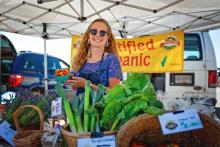Central Saanich has a rich history of farming, and it is an important element of economic activity within the community. About 60 per cent of the District’s land base is Agricultural Land Reserve (ALR). Western-style agriculture has been practiced on the Saanich Peninsula since shortly after the settlement of Victoria in 1841. Beginning in the 1860s, local food was grown to support the increasing population as settlers arrived. The historical Saanich Fair has been held in Central Saanich on Labour Day weekend since 1867 and showcases the bounty harvested in the region.
Central Saanich agriculture has at various times comprised many farm types, including grain, dairy, poultry livestock, tree fruit, tree seed, field flowers/bulbs, nursery, and vegetable production. With changing farm economics, some farm types have declined, and others have increased in number. Various agriculture-related services, including suppliers and processors, have changed over time.
The Statistics Canada Agriculture Census was last conducted in 2021 and released in 2022. The results of the census relating to Central Saanich can be found here. It shows the farm activity and outputs, employment in the sector and scale of operations within the District.
Farm operators provide food in many ways within the District from farm gate sales, farmer’s markets, local grocers and beyond. A variety of crops and livestock are harvested here and throughout the year on small to medium-sized plots and greenhouses.
If you are looking for farm products in our region, here are a few resources.

- Peninsula County Market at the Saanich Fairgrounds. http://peninsulacountrymarket.ca/
- Island Farm Fresh https://islandfarmfresh.com/farm-location/saanich-peninsula/
- BC Farms and Food https://bcfarmsandfood.com/farm-map/
Agriculture Resources
If you are a farm operator or processor and looking for support or resources some can be found here.
Labour support
- WorkBC - https://www.workbc.ca/Employer-Resources.aspx
- Government of BC - https://www2.gov.bc.ca/gov/content/employment-business/employment-standards-advice/employment-standards/hiring/farm-workers
- Canada – Foreign Workers Program - https://www.canada.ca/en/employment-social-development/services/foreign-workers.html
Grants & Programs
- Government of BC - https://www2.gov.bc.ca/gov/content/industry/agriculture-seafood/programs
- Government of Canada - https://agriculture.canada.ca/en/agricultural-programs-and-services
- Government of Canada – AgriInnovate Program - https://agriculture.canada.ca/en/agricultural-programs-and-services/agriinnovate-program
- Government of BC – Knowledge and Technology Transfer Program - https://www2.gov.bc.ca/gov/content/industry/agriculture-seafood/programs/knowledge-transfer-events
- Canada – BC Agri-Innovation - https://www2.gov.bc.ca/gov/content/industry/agriculture-seafood/innovation-and-technology
- Investment Agriculture Foundation - https://iafbc.ca/
- Agritech Canada - https://www.britishcolumbia.ca/industries/agri-technology/
- Canada – BC – AAFC – Funding Opportunities - https://bcfarmersmarket.org/app/uploads/2021/07/AAFC-Funding-Opportunities-Booklet_Jan-2021.pdf
Succession Planning
A succession plan is an ongoing process to ensure management, skills, processes, knowledge, ownership and control of a farm transition properly from one generation to the next. The key is to develop a comprehensive transition plan that addresses the diverse needs of the family on an ongoing basis.
Based on agriculture census data many farm operations still need to consider this important aspect of their farm business. It can be a long process to ensure your farm operation continues to the next generation and help you transition your operation more smoothly.
There are many options to consider such as a transition transfer to family members or non-family. Is it a quicker or long-term operational transfer and how is the operation purchased? Ask for feedback from other farms that have gone through the succession process to see if there is a way that works for you. There are organizations that can aid in this process such as Farm Credit Canada and the Young Agrarians.
- Government of BC - https://www2.gov.bc.ca/gov/content/industry/agriculture-seafood/business-market-development/agrifood-business-management/transferring-a-farm/succession-planning
- Farm Credit Canada - https://www.fcc-fac.ca/en/resources/transition-planning.html
- Young Agrarians - https://youngagrarians.org/tools/land/farm-transition/


